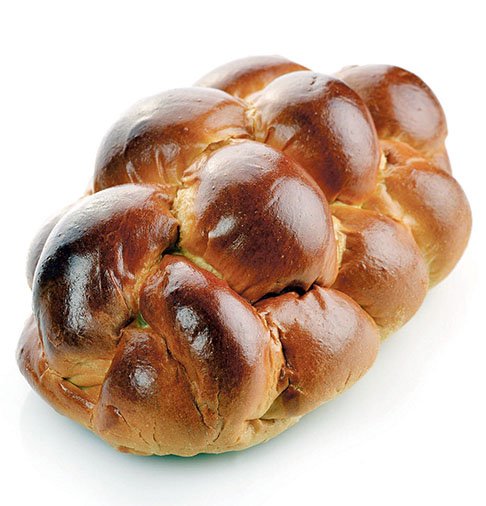“I’ve baked a loaf of bread.” These are such simple words. Yet if you say them to family or friends, especially during the holidays, there’s a very good chance they’ll be greeted with awe, admiration and gratitude.
Nothing you can make impresses in quite the same way. After all, bread is considered elemental sustenance. Who hasn’t heard it referred to as “the staff of life” or read the classic romantic yearning of “The Rubaiyat of Omar Khayyam” for “A Jug of Wine, a Loaf of Bread — and Thou Beside me singing in the Wilderness”?
There will be no trace of wilderness on your holiday dining table if it features some good bread. And if you’ve made the bread yourself, for your own celebration or a party to which you’ve been invited, many of those gathered will feel the bread has transformed the meal into a feast — regardless of whether the loaf accompanies a glorious roast or humble leftovers.
As you’ll discover while making the recipe I share here for Braided Egg-and-Butter Loaf, you can accomplish that feat with relative ease. Thanks to the mixing and kneading help supplied by a stand mixer, which so many home cooks have in their kitchens today, and the seemingly miraculous action of the benevolent microorganisms known as yeast to make the dough rise, most of the work of making bread is done for you while you simply sit back and let it happen.
Of course, you do have to measure your ingredients carefully and check to make sure you provide the correct water temperature and room temperature for, respectively, activating the yeast and letting the dough rise. (If you need to go out, you can slow down the rising process by refrigerating the dough, which will then take about 4 times longer.)
A close cousin of French brioche and Jewish challah, my recipe also involves dividing the dough into two equal batches (for two loaves), then dividing each batch into three equal pieces that are rolled out into ropelike shapes and braided. Please don’t be intimidated by this task. It’s surprisingly similar to braiding hair into a pigtail; and even if you’ve never done that, you’ll find it easy to follow the simple, methodical instructions I include here.
Try making this bread for any forthcoming holiday party. (If you observe Jewish dietary laws, in which dairy and meat are not mixed, you can substitute water for the milk and 1/2 cup of vegetable oil for the butter.) The dough freezes well, too — just wrap it airtight in plastic, then in aluminum foil.
Here’s to a holiday season filled with awe, gratitude and good food.
BRAIDED EGG-AND-BUTTER LOAF
Makes 2 large loaves
Dough:
1 tablespoon plus 2 teaspoons (2 packets) active dry yeast
2 cups warm milk, 80-90 degrees
1/3 cup granulated sugar
6 cups bread flour or all-purpose (plain) flour, plus extra for kneading
6 tablespoons unsalted butter, melted
3 large cage-free eggs, at room temperature
2 teaspoons salt
Cornmeal, for sprinkling
Egg wash:
1 large cage-free egg
1 tablespoon water
Poppy seeds or sesame seeds, optional
Directions:
In the bowl of a stand mixer, combine the yeast and 1 cup of warm milk; stir to dissolve. Add the sugar and 2 cups of the flour, and mix with the paddle attachment at medium speed. When smooth, cover the bowl with plastic wrap and leave in a warm spot until bubbly, 45 minutes to 1 hour.
Add the remaining warm milk, and with the paddle at medium speed, beat in the butter. One at a time, beat in the eggs. Combine the remaining 4 cups flour with the salt, and add all at once to the mixture. Mix with the paddle. Then switch to the dough hook, and knead at low speed for 2 minutes, then medium speed for about 8 minutes, until a smooth dough forms, adding a little more flour if the dough looks too sticky.
Scrape out the dough onto a lightly floured work surface, and finish kneading by hand, about 1 minute. Shape the dough into a ball.
Clean and dry the bowl. Lightly butter or oil it, and return the dough, rounded side down first, to the bowl; then turn the dough rounded side up to coat it. Cover the bowl with plastic, and set aside in a warm, draft-free place until doubled in bulk, 1 1/2 to 2 hours.
Turn out the dough onto a lightly floured work surface. Cut the dough in half. Cut each half into 3 equal pieces. Roll each piece back and forth between your fingers to form an even strand 18 inches long. Pinch the ends of 3 strands together, and stretch them out parallel to but 2 to 3 inches apart from each other; then braid by alternately lifting the right-hand strand over the middle one, and then the left-hand strand over the middle. Finally, pinch the other ends together, and tuck both ends neatly underneath. Repeat with the remaining 3 strands to make a second loaf.
Sprinkle a large baking sheet with cornmeal. Transfer the loaves to the sheet, spaced about 3 inches apart, or use 2 sheets. Beat together the egg and water, and gently brush over the loaves. Sprinkle with poppy or sesame seeds if you like. Cover the loaves with 1 or 2 clean, damp kitchen towels, and leave the loaves to rise until nearly doubled in bulk, about 1 hour. If using 2 baking sheets, place 1 in the refrigerator, removing it after 1 hour.
About 30 minutes before baking, preheat the oven to 350 degrees. Position the topmost rack in the middle of the oven. Place the baking sheet on the middle rack, and bake the loaves until they are deep mahogany brown and sound hollow when rapped on the bottom with a knuckle, about 45 minutes. Transfer to wire racks, and cool to room temperature before slicing and serving.
